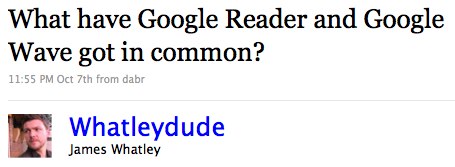“It’s good to talk”
As promised in my last post, this next one is a bit of a biggie. Sitting comfortably?
Then I’ll begin…
Towards the end of last year, around the start of December in fact, I found myself having a conversation with fellow Mobile Industry Review contributor, Jonathan Jensen. He and I were discussing that as we move into 2009, brands should be placing a certain level of importance on engaging with their consumers on an increasingly more conversational level.
The exact words that struck such a chord with Jonathan were as follows:
‘2007: Content was King. 2008: Context is King. In 2009? Conversation will be King.’
At that point however, I had to dash off to do a presentation for SpinVox and never got the chance to elaborate on that thought any further.
What I mean is; back in the ring tone & wallpaper days of 2005-7 (does anyone below the age of 16 actually use those services anymore?), everywhere you went the mystic phrase was uttered; ‘content is king’
The content in this instance is the aforementioned downloadable premium additions to your handset. During my job at Mobizines (and subsequently Mippin), we were still seeing presentation after presentation and report after report, all supporting (or at least purporting to) this concept – as late as this time last year in fact.
And we lapped it up.

2007 came and went, and sharing was set to be the theme for 2008 (that was my prediction anyway) and you could argue that this was proven to be correct in a number of ways.
In the future, people will look back and say that Facebook was instrumental in introducing Social Media to the masses. It unified communications on a consumer level and gradually allowed people to begin sharing.
Of course, the ‘Content is King’ mantra did not just disappear with the twilight of the year. The legacy lived on, rearing its ugly head once again, this time in the form of Facebook Applications. With only a few exceptions, this first swathe of applications; including Werewolves, Ninjas, Sheep Throwing and more, were soon replaced with some contextual goodness.
The adverts soon followed suit; “Your friend ‘x’ likes this, so you will like it too…”
It’s hardly a trusted referral from a non-branded, independent entity, but it’s not far off.
We’ll come back to this point later as, before we look at trusted referrals, we need to return to content for a moment – and how that lineage spreads into Social Media.
Facebook for example, gives you contextual content from your friends. If you give any content just a smidgen of context, suddenly you’ll find you have the potential for engagement. Facebook, by turning content over to its users, allowed context to become king – almost overnight.
Context gives content meaning, and is at the centre of any Location Based Service actually ever becoming successful. Context also adds to the ambient awareness that Facebook has brought upon us all. Knowing where my friends are and what they are doing is not only easy to implement, but also fantastically simple to engage with. Comment on this, write on that, post it here – Facebook makes it so easy. Some people choose to have a constant stream of ‘noise’ flowing through them at all times, but it’s the content from your friends that is important. That is the context.
As I said in Helsinki;
“YOU are the stream, everything else is just the channel you use to publish your content…”
So that’s the consumers sorted. What about advertising?
For that, I’m going to use another quote;
“A trusted referral from a non-branded independent entity is more powerful than any amount of advertising, marketing or PR.”
– Blake Chandlee, MD Facebook Europe.
For me, this can be simply illustrated as follows: You and I are in a pub, posters surround us for Beer X, but everyone around us is drinking Beer Y.
I ask you which one you’d prefer and you say; “I’ll have what you’re having”.
When you use the same example, but add in the context of Facebook, you find that it becomes;
“Your friend likes this, so you should too.”
Alas, the latter is missing context. The pub example outlined above works because both you and I are there together, and we’re there to drink together, (two words: social objects).
The addition of an advertiser – in this case on Facebook – does not work, as there is no human context involved. It has attempted to do what I like to call ‘content wrapping’ – making an advert that has no relevance to me appear meaningful.
There is a massive difference between “I’ve done this, so you must do it too” and “I’ve done this, I loved it and here’s why you’d love it too”. It is the equivalent of me talking to you as an individual, instead of an advertiser using my profile picture to endorse its brand.

You get my meaning…
In 2008, people and brands began to realise that without context, content is rendered meaningless. Now in 2009, the tide is turning and advertisers are beginning to understand that old school games of ‘scattergun marketing’ just don’t work anymore.
This is nothing new, nor is it by any stretch of the imagination, rocket science. I’ve talked about this before numerous times. However, to give this piece context (see – it is important), I need to re-iterate a couple of things.
In 2008 – the year of sharing – context was most definitely king. Any person’s homepage on Facebook (that most people look at daily) was, and still is, very smart. It displays interesting content created by people you know (which immediately provides context), which was specifically created for you.
If that’s not targeted advertising, I don’t know what is.
Funnily, you know what else it is?
SOCIAL MEDIA
But enough of that. Let’s look forward. To 2009. To the year of CONVERSATION.
At this point it should be noted that these opinions are my own and are based on my personal experiences & knowledge of this particular space, in this particular part of the world.
In other markets, I am well aware that content is still reigning king and that context is quietly plotting its imminent downfall.
In the same way traditional marketing and advertising methods are being scrapped in favour of more intelligent niche or hyper-targeted practices, in this coming year brands will realise the benefit of engaging with their consumer on a more conversational level
Don’t get me wrong, some are doing it already, there are MANY forward-thinking brands out there doing just that.
Last year, when I wrote about being human, I talked about how the guys that will do well in this coming year will the ones that want to have genuine conversations with their consumers.
And I stand by it.









